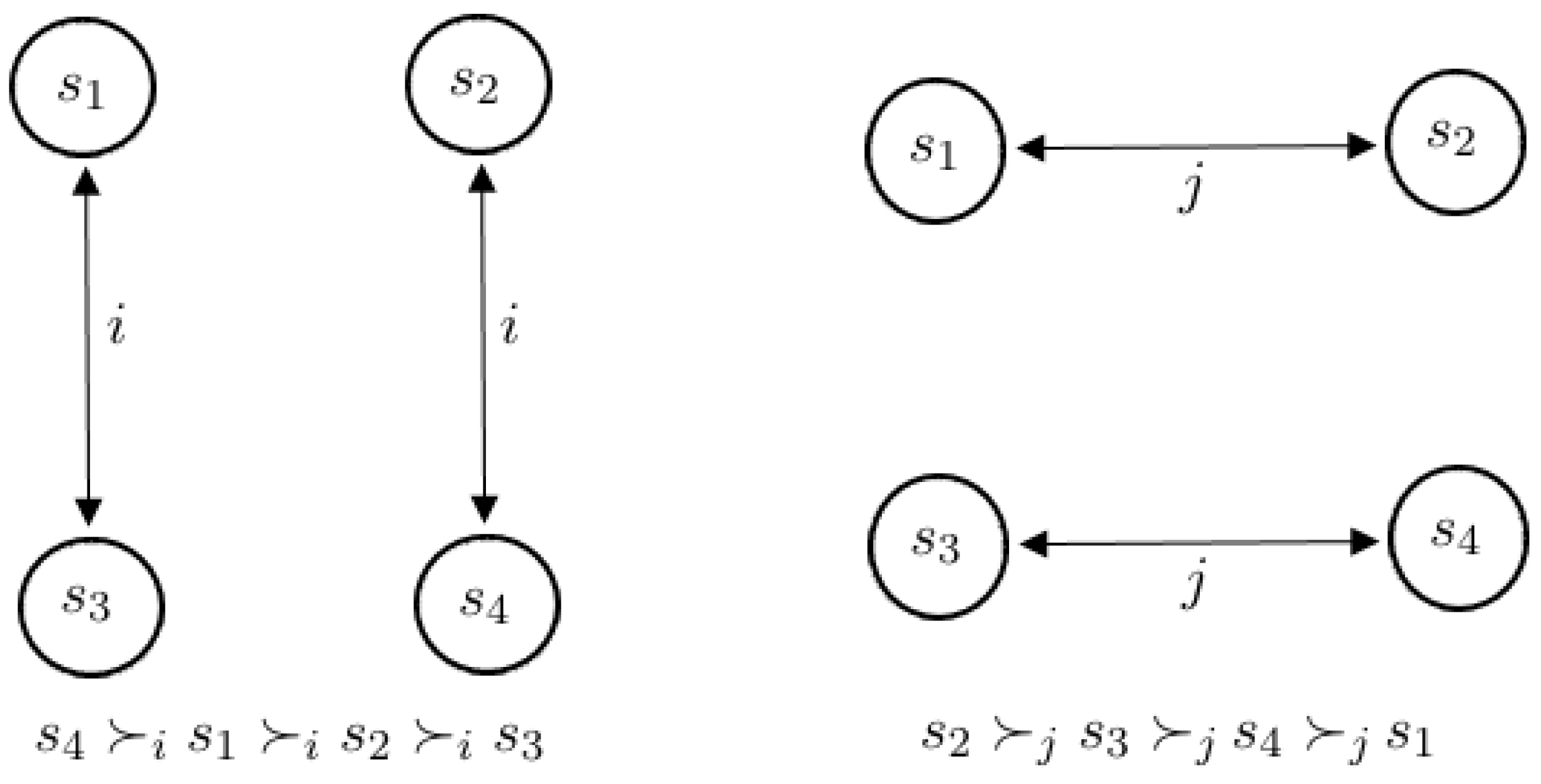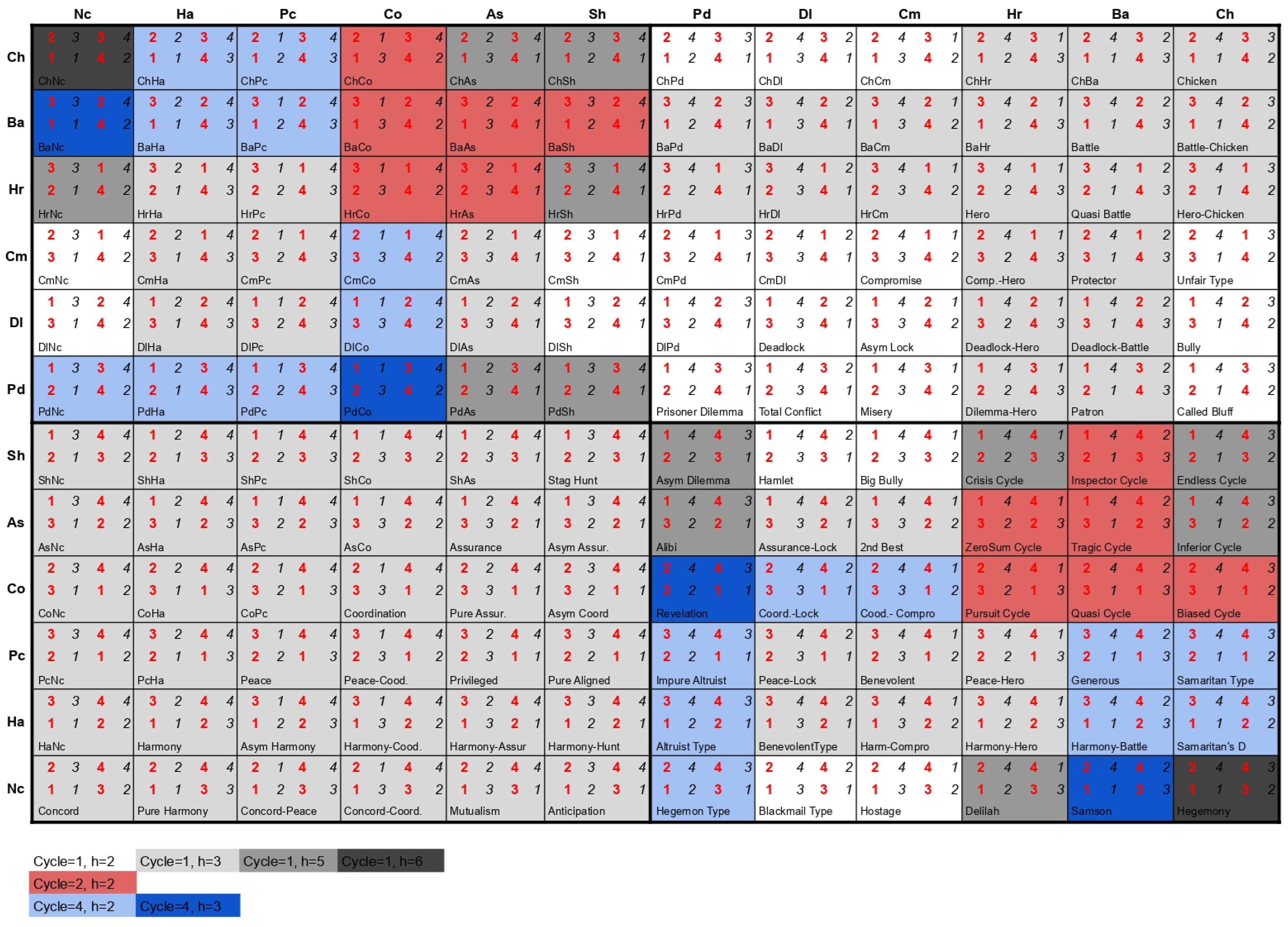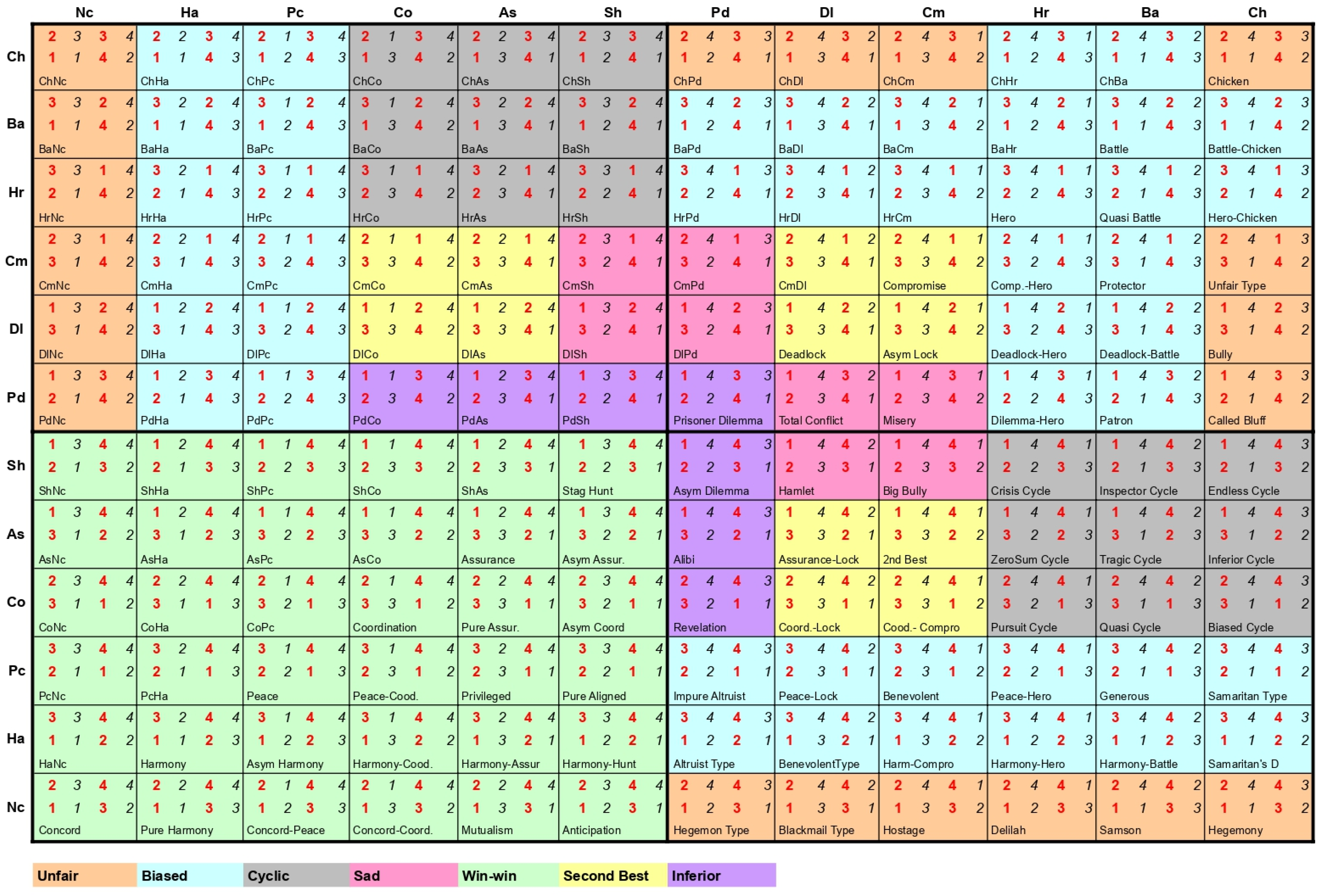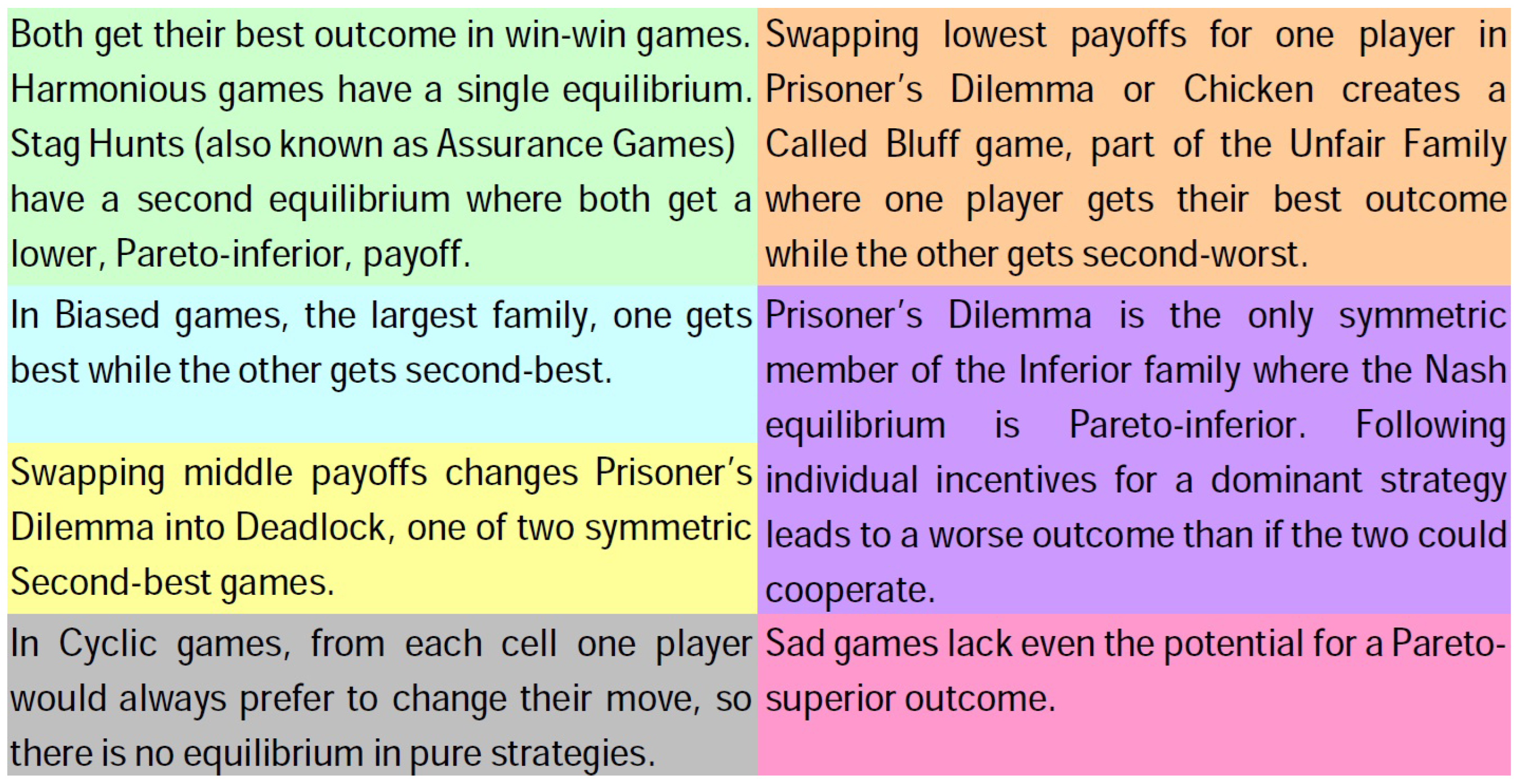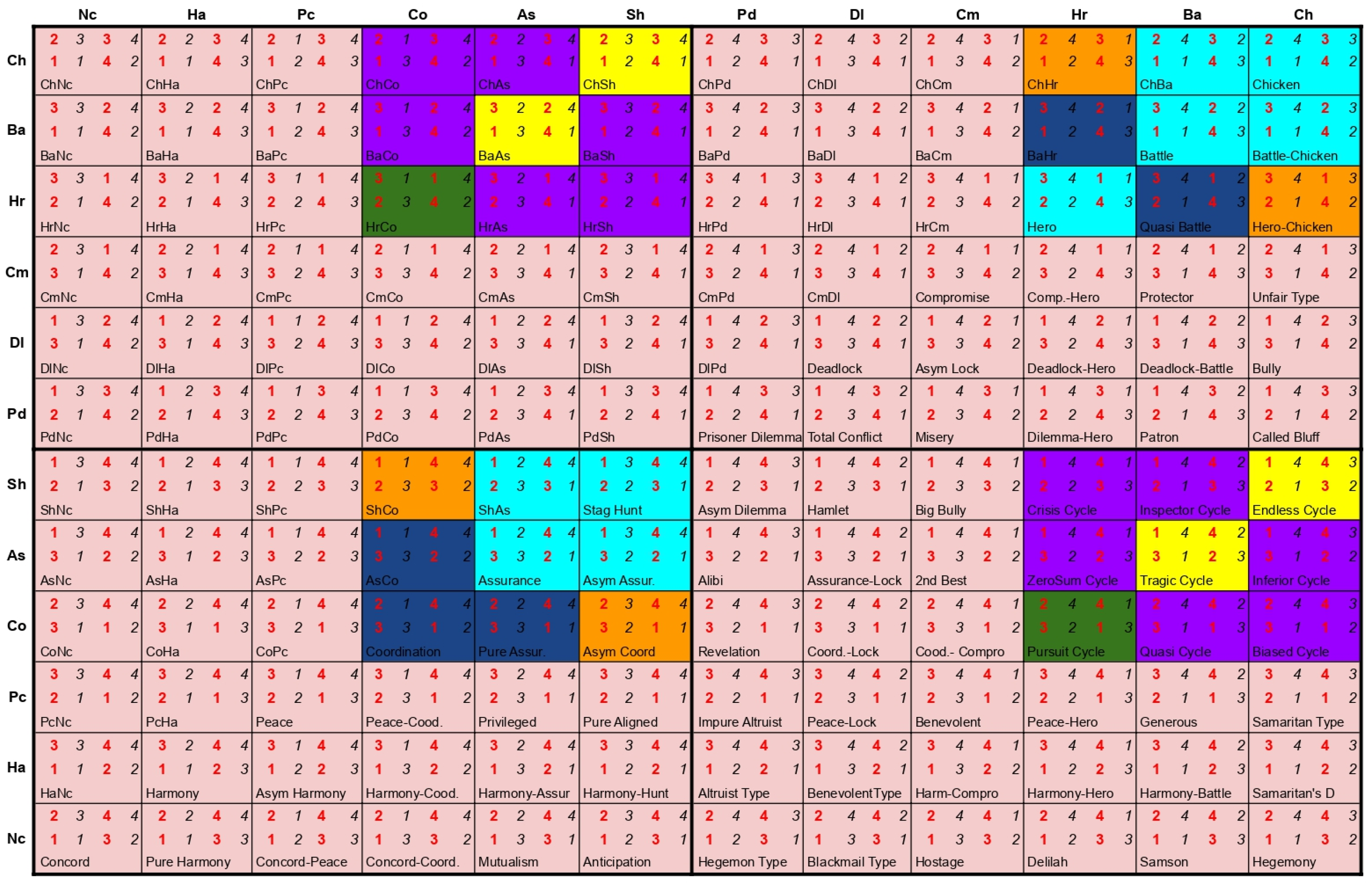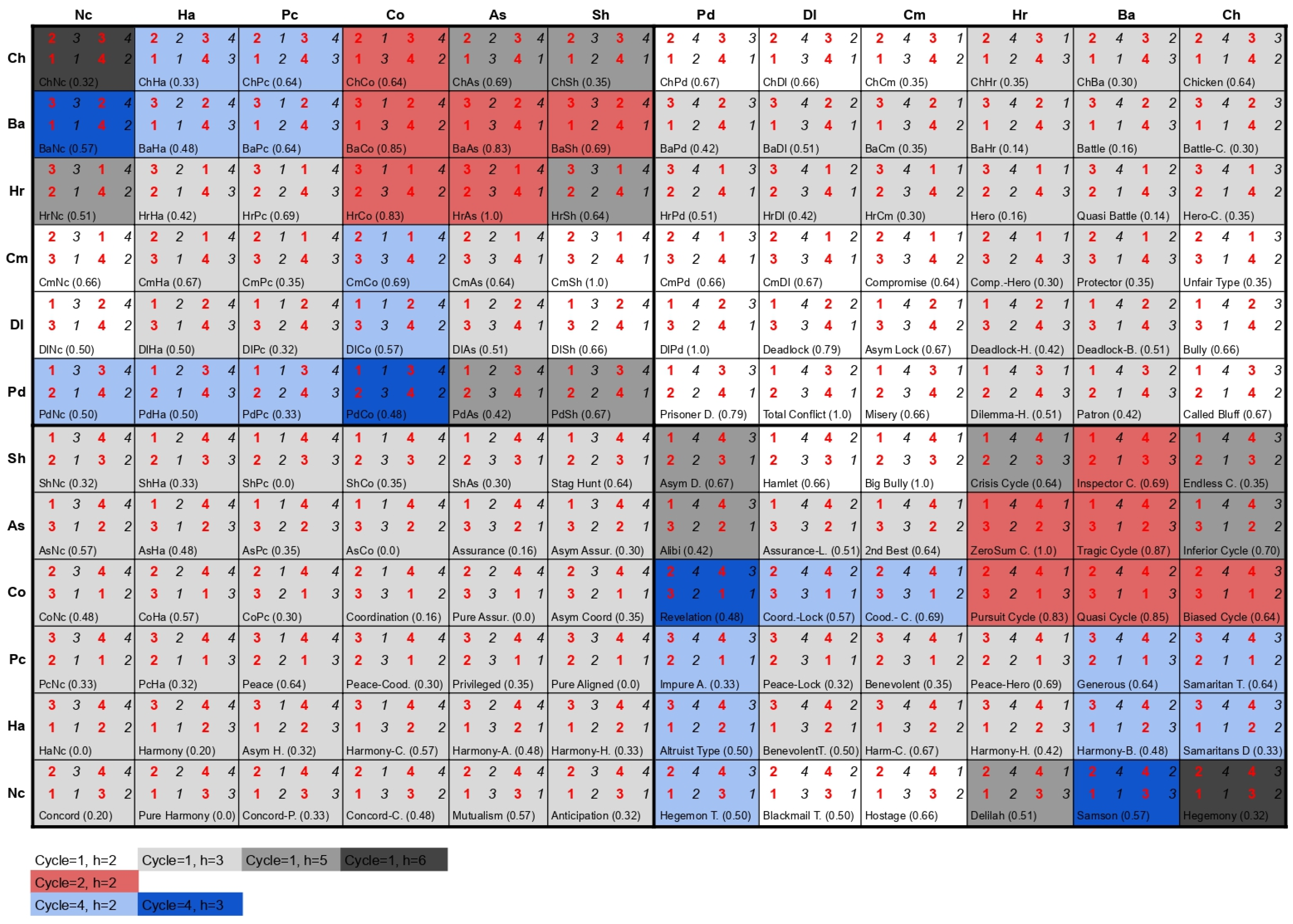1. Introduction
We must make personal or professional decisions almost daily, often seeking resources to help us with our choices. Each agent’s decisions can affect others, often resulting in a strategic conflict. To make decisions rationally, a decision maker (DM) must define his or her goals and then assess which choices best achieve and balance these goals. Conflict analysis methods can help evaluate possible courses of action by predicting the reactions of others and the eventual outcomes, thus facilitating decision making.
Based on tools from conflict analysis and game theory,
Kilgour et al. (
1987) proposed a mathematical approach to model and analyze strategic conflicts. The graph model, or Graph Model for Conflict Resolution (GMCR), describes and analyzes patterns of behavior for DMs in strategic conflicts, and is designed to be easy to apply in real-world contexts.
According to the graph model, a conflict is always in one of several possible states; actions by DMs cause the conflict to shift from one state to another. Stability analysis aims to determine, for each state and each DM, whether the DM would choose to move away from that state if it were the current state. A state is stable for a DM who either cannot move away from it or could move away but would choose not to. This choice of moving or not is made in anticipation of the reactions of other DMs to the initial move. The many behavior patterns, or stability definitions, that have been proposed for the graph model are essentially models of the reactions of other DMs as expected by the focal DM. The most common of these stability definitions are listed below, in
Section 2.1, with references.
Two particular stability definitions proposed early in the history of the graph model are limited-move stability with horizon
h (
) and non-myopic stability (
) (
Kilgour, 1985). The former,
stability, the primary topic of this paper, has been recognized as the source of complicated cyclic behavior. Since the latter topic,
stability, is a limit of
stability as
h increases without bound, our study in fact sheds light on both of these long-standing but poorly understood stability definitions.
The arena for our study is the set of strict ordinal
games, as described in the “periodic table” set up by
Bruns (
2015b), based on the ideas of
Robinson and Goforth (
2004). The class of games with two players, each with two strategies, and each with a strict ranking of the four possible outcomes, was first identified by
Rapoport and Guyer (
1966). It is a natural place to study strategic principles that depend only on the ordering of outcomes, such as dominance and pure-strategy Nash equilibria (
Brams, 1977;
Brams & Kilgour, 2009;
Gimon & Leonetti, 2025;
Rapoport et al., 1976). It has been rearranged (
Brams, 1977) and extended in various directions (
Fishburn & Kilgour, 1990;
Fraser & Kilgour, 1986;
Kilgour & Fraser, 1988); it continues to find interesting uses for other purposes (
Omidshafiei et al., 2020).
The notion of limited-move stability takes the positive integer h as a parameter, and assumes that the focal DM anticipates h steps into the future. This DM asks what the final state will be if all DMs make choices to achieve the best final scenario possible for themselves within the h-move horizon, assuming that the preferences of all DMs are common knowledge. Note that each DM’s choices depend only on his or her relative preferences for outcomes—information that is always available in the context of ordinal games.
The main contributions of this work are as follows:
To explore (see below) the dynamic and oscillatory behavior associated with stability, determining the lengths of cycles and the horizon where cycling emerges for each one of the strictly ordinal games;
To confirm the conjecture of
Fang et al. (
1993) that, for
games, all cycles have lengths 1, 2, or 4;
To compare the classification of 2 × 2 games thus obtained with related classifications in the literature.
There are important ramifications for a number of fields involving bounded rationality and strategic interaction from the study of games with a finite horizon. Such analysis provides more realistic decision-making analysis in artificial intelligence and reinforcement learning by modeling and training agents that function under cognitive or computational limitations. These bounded agents are appropriate for real-time systems or situations with constrained processing capacity because they can learn to predict the immediate effects of actions without needing complete solution paths.
In strategic negotiation settings, as in political or diplomatic conflicts, limited-horizon reasoning captures how real-world DMs often make decisions without full foresight, instead relying on short-term planning and heuristics. This is particularly relevant in modeling human negotiations or multi-agent systems where DMs must act under time pressure or informational constraints.
In general, limited-horizon game analysis bridges idealized rational models with actual strategic behavior by providing a tractable yet effective method of investigating decision making with bounded foresight. This work is of practical significance in all those domains because it offers a comprehensive knowledge of the cyclic behavior that arises in such analysis.
The concept of limited-move stability originated in the work of
Zagare (
1984). In that work,
games are classified according to limited-move equilibria, a closely related concept. However, the analysis is limited to horizons up to 4, what the author calls rules I, II, III, and IV. Moreover, that work classifies games according to whether all or some equilibria remain the same for some or all horizons up to four. The present research considers any finite horizon and observes the cyclic behavior of the whole set of states and not only of the equilibrium states.
This work is organized as follows: In
Section 2, a theoretical background about the GMCR and the limited-move stability is presented.
Section 3 contains the main findings of this work, which is the determination of lengths of cycles and the horizon where cycles begin in all
strictly ordinal games. A comparison with other results in the literature is made in
Section 4. Finally,
Section 5 concludes the paper by summing up the contributions and questions for future works. The definitions of all symbols and abbreviations used in the manuscript can be found in “Symbols and Abbreviations” at the end of the conclusions.
2. Theoretical Background
2.1. Graph Model for Conflict Resolution
The Graph Model for Conflict Resolution (GMCR) (
Kilgour et al., 1987) is a flexible mathematical tool designed to model and analyze the interactions of DMs through their possible moves and countermoves. Formally, a graph model has the following several components:
The set N of all DMs acting in the conflict;
The set S of all feasible states of the conflict, generally consisting of all possible combinations of actions that the DMs can take;
For each DM , a loop-free directed graph, , where the set of nodes (common to all DMs’ graphs) is S, the set of states, and specifies the state transitions controlled by DM i;
For each DM , a preference structure on S that is usually taken to be an asymmetric ir-reflexive binary relation, denoted by , where, for states , means that DM i strictly prefers state s to state t.
In GMCR, accessibility is often represented by sets of unilateral moves (UMs), represented by , where a state belongs to if it can be accessed by DM i, from state s, in a single step. Formally, the definition is .
Together, DMs, states, accessibility relations, and preferences constitute a model of a conflict. The next step, stability analysis, predicts which states are possible outcomes. Specifically, this analysis verifies, for each state of the conflict, which DMs would be willing to move away from the state (if it were the current state). In the GMCR literature, there are many stability definitions that describe the interests of DMs in moving away from a state. Effectively, they are models of DMs’ strategic behavior in conflict situations. In all of these definitions, stability is analyzed from the point of view of a single DM, called the focal DM. A state that is stable according to a particular stability notion for every DM in the graph model is called an equilibrium under that stability definition.
The most commonly used stability definitions are those of
Nash (
1950), general metarationality (GMR) (
Howard, 1971), symmetric metarationality (SMR) (
Howard, 1971), sequential stability (SEQ) (
Fraser & Hipel, 1984), and symmetric sequential stability (SSEQ) (
Rêgo & Vieira, 2017). Intuitively, in Nash stability, the focal DM, ignoring the possible reactions of opponents, chooses to move if and only if a preferable state is reached. In
and
stabilities, the focal DM asks whether opponents can sanction the initial move by taking the conflict to a state that the focal DM does not prefer to the initial state. These concepts differ in that, under SEQ, the opponents react only with improvements, while under GMR, sanctions are not necessarily improvements for the sanctioner. Thus, SEQ stability is stronger in the sense that both the initial move and the sanction must be “credible”; under GMR, this adjective applies only to the initial move. In the SMR and SSEQ concepts, the focal DM analyzes the possible responses of the opponents, exactly as with GMR and SEQ, but in addition, the focal DM also asks whether the sanction can be escaped by a further move—that is, whether a state preferable to the initial state can be reached in three moves. Like GMR, SMR allows non-credible sanctions; like SEQ, SSEQ insists that sanctions be credible. All these stability definitions have a common feature: each allows a fixed number of moves and countermoves—1, 2, or 3—and thus has a fixed horizon.
An early stability notion that can be used with any horizon is limited-move stability (
). It specifies that the focal DM decides whether to move by considering the final state that would be reached after a maximum of
h moves, assuming that other DMs make choices to achieve the best final outcome for themselves. Of course, final outcomes, and
stabilities, may change as
h changes. In fact, oscillatory and periodic behavior has been noted in some cases, even when all DMs anticipate the same final state if the horizon is long enough
Fang et al. (
1993).
In this paper, we are particularly interested in identifying the length and the initial horizon of cycles in stability in graph models obtained from games. We interpret each outcome as a state, and preserve the accessibility relation inherent in the original game. We next describe the notion of stability in detail, for the context of graph models with DMs, where represents the cardinality of a set.
2.2. Limited Move Stability
In stability, DMs are allowed to perform a maximum of h actions and counteractions. In this concept, the focal DM anticipates, h steps ahead, what the final state of the conflict will be, considering that decision makers always change their actions in order to reach the best possible scenario for themselves, and that the preferences of all DMs are common knowledge.
Our approach is to assume that each DM has preferences on
S that are complete, transitive, and asymmetric. To work with this concept, let
be the cardinality of the set of states that are less preferred than state
s for DM
i. Formally, we have that
. For
,
, and
,
is the state that DM
i anticipates will be the final state of the conflict if the conflict starts in state
s, DM
i moves first, DMs alternate moves, at most
h moves are made, and each DM chooses its moves so as to achieve the best final state for itself and expects the other DM to do likewise. By convention,
and, for
,
is constructed recursively as follows:
where
and
Intuitively, the anticipated state will be equal to s if DM i cannot move away from s or if s is at least as preferred as the most preferred state that can be anticipated at horizon by DM i when DM i moves away from state s and its opponent responds, with horizon . Otherwise, . It is worth pointing out that, in the case of conflicts described by games, is always equal to the unique element in , since is always a singleton set.
Note that, in the limited-move stability concept, not only are DMs’ preferences over states common knowledge, but also it is common knowledge that all DMs make moves that are most beneficial to themselves at each horizon
.
Figure 1 provides a step-by-step flowchart to calculate the final anticipated state
. The formal definition of limited-move (
) stability is as follows:
Figure 1.
Step-by-step flowchart to calculate .
Figure 1.
Step-by-step flowchart to calculate .
Definition 1 (
Kilgour, 1985)
. A state is () stable for DM , or stable according to the limited-move stability concept with horizon h, if and only if . We refer the reader to the examples described in
Section 3 for a better understanding of the
stability and all the notation defined in this section.
2.3. Cycles in Stability
Cycles in stability are periodic or oscillatory trajectories as a function of the horizon h that arise in the dynamical system, considering the stability properties. This implies that, even if the system may have a stable equilibrium point , it may also present periodic or oscillatory dynamical behaviors when the horizon of analysis h varies.
Formally, Definition 2 establishes the meaning of a cycle in the stability.
Definition 2 (
Fang et al., 1993)
. A game enters a cycle of length r, starting from horizon h, if , for every integer t such that , all , and all , with h and r being the smallest integers with this property. Note that, by the definition of stability, is the state that DM i anticipates as the final state when the initial state is s and the horizon is t. If the model enters a cycle of length r at horizon h, then, for any number of increments of size r in the horizon, each DM anticipates the same final state from any initial state. For example, in a game that presents a cycle of length 2, if the horizon is large enough, then whenever the horizon is increased by 2, the anticipated states will be the same for all DMs from all states of the conflict.
A game that has a cycle of length 1 is said to have a fixed point. However, cycles of other lengths are possible.
Fang et al. (
1993) stated that, of all the games analyzed so far, only cycles of length 1, 2, or 4 had been encountered, and conjectured that these are the only possibilities. In this work, our main objective is to investigate cycles in all
games and identify the cycle length and the horizon at which cycles begin.
2.4. Strict Ordinal Games
The class of games with two players, each with two strategies and no indifference among the four outcomes, was first identified by
Rapoport and Guyer (
1966). It can be categorized into 12 distinct payoff patterns for each DM. This classification derives from the fact that there are
permutations of the numbers 1 through 4, which we divide by two so as to identify those that are distinct only due to the names of the DMs’ strategies. For example, describing the Prisoners’ Dilemma with “Defection” on the top line and “Cooperation” on the bottom (reversing those strategies) does not change the game in any essential way. These 12 patterns are named according to the names of the symmetric games that they generate: No Conflict/Concord (Nc), Harmony (Ha), Peace (Pc), Coordination (Co), Assurance (As), Stag-Hunt (Sh), Prisoners’ Dilemma (Pd), Deadlock/Anti-Prisoners’ Dilemma (Dl), Compromise/Anti-Chicken (Cm), Hero (Hr), Battle of the Sexes (Ba), and Chicken (Ch).
Thus, in principle, there are 144 strictly ordinal games. However, if both DMs switch roles, the conflict does not change, generating a symmetry. In fact, there are 12 symmetric games in which both DMs have the same pattern of behavior (such as the Prisoners’ Dilemma, Chicken game, Stag-Hunt, etc). For each of the remaining 132 games, where DMs have different behavioral patterns, there is a symmetric one where the behavioral patterns of the DMs are reversed. For example, one DM playing the Chicken game and the other playing the Prisoners’ Dilemma (ChPd) is the same game (PdCh), where the roles of the DMs are reversed. Thus, they share the same result in any strategic analysis, and consequently, there is no need for duplication, only repetition of the results found. By dividing the 132 distinct games by two, we obtain 66, which added to the other 12 symmetric games’ result in the 78 distinct games that were analyzed according to the cycle.
3. Cycles in Games
We analyze each of the 78 distinct games for their cycle. Example 1 illustrates our methodology with an example of a game that enters into a cycle of length 2 from horizon .
Example 1. To illustrate the concept of cycles in the stability , consider the game BaCo, of which the normal form is displayed in Table 1. The game BaCo is the one in which the utilities of the row player are according to the Battle of the sexes game and those of the column player are according to the Coordination game.
This game can be treated as a graph model. By convention, we will use and to represent the states of the cells in the first row and and to represent the states of the cells in the second row. We will call the DMs of this game DM i and DM j. Note that since DM i can alter their position in the conflict by switching rows, and DM j can do so by switching columns, the graph model representing this conflict, along with the DMs’ preferences over the conflict states, appears in Figure 2. Since this same convention is used for all games, it follows that, for any given , the sets and are the same in all games. Consequently, for any given , the value of the function is the same for every horizon and every game, as it can be seen in the tables of Examples 1 and 2. For didactic purposes, before studying the problem of cycles in this example, we illustrate how to analyze the limited-move stability of state for DM i considering a horizon . Figure 3 displays a tree with all sequence of alternate moves that DMs i and j can make starting from a move of DM i from state and considering at most five moves in the sequence. To obtain the anticipate the final state , we need to analyze first the final moves of the DMs. In this example, the final move that can be made is a move from DM i considering horizon 1 from state . Since , it follows that and . As , we have that . Moving one step above, from state , DM j can only move to and anticipates that the conflict will end in because . Thus, it follows that and . As , it follows that . Continuing one more step above in the tree, from state , DM i can only move to and anticipates that the conflict will end in because . Thus, it follows that and . As , it follows that . Going one more step above in the tree, we have that, from state , DM j can only move to and anticipates that the conflict will end in because . Thus, it follows that and . As , it follows that . Finally, at the initial move of DM i from , we have that DM i can only move to and anticipates that the conflict will end in because . Thus, it follows that and . As , it follows that , which implies that state is stable for DM i. We will use the procedure described above to analyze the stability of the states for values . Considering , we present in Table 2 the results of the stability analysis for both DMs of the conflict. Note that states and are stable for DM i and states and are stable for DM j. Considering now , Table 3 presents the results of the stability analysis for DMs i and j. Note that states , , and are stable for DM i and states , , and are stable for DM j. Now, considering , Table 4 presents the results of the stability for DMs i and j. We have that states , , and are stable for DM i, while states and are stable for DM j. Considering , Table 5 presents the results of the stability for i and j. Note that , , and are stable for DM i, while states , , and are stable for DM j. Note also that this is the same result obtained in the stability analysis. Considering now , Table 6 presents the results of the stability for DMs i and j. We have that states and and are stable for DM i, while states and are stable for DM j. Note also that this is the same result obtained in the stability analysis. From the tables, we can see that, starting at horizon , the BaCo game enters a cycle of length 2, i.e., the state anticipated by DM i (resp., DM j), from a state , considering that a horizon is the same state anticipated, from s, considering a horizon t, for every integer .
Example 2 discusses the analysis of a game that has a fixed point (cycle of length 1) from horizon .
Example 2. In this example, we consider the ChAs game, whose normal form is presented in Table 7. Analogously to Example 1, this game can be represented as a graph model in which the states, DMs, and accessibility relations are identical to those in Figure 2, except for the preference orderings of the DMs. Specifically, the preferences are now given by for DM i, and for DM j. Following the same procedure as in the previous example, we now examine the stability of the states in the ChAs game for horizons . We begin with . Table 8 reports the results of the stability analysis for both DMs in the conflict. Note that states and are -stable for DM i, while states and are -stable for DM j. For , the results of the stability analysis for DMs i and j are summarized in Table 9. It can be observed that states , , and are -stable for DM i, whereas states and are -stable for DM j. To the case , Table 10 reports the outcomes of the stability analysis for DMs i and j. In this setting, states , , and are -stable for DM i, whereas states and are -stable for DM j. For the horizon , the outcomes of the stability evaluation for DMs i and j are displayed in Table 11. In this case, states , , and are -stable for DM i, whereas states and are -stable for DM j. When the horizon is to , the stability outcomes for DMs i and j are reported in Table 12. In this case, states , , and are -stable for DM i, whereas states and are -stable for DM j. Finally, for horizon , Table 13 presents the outcomes of the stability analysis for DMs i and j. In this scenario, states , , and are -stable for DM i, while states and are -stable for DM j. It is worth noting that all anticipated states for both DMs considering a horizon are identical to those observed considering the horizon . Moreover, since, by definition, the anticipated state considering a horizon h only depends on the anticipated states that consider an immediately previous horizon; for all , the anticipated states will continue to be the same. Thus, the analysis enters into a cycle of length 1 from horizon . Finally, it is also worth pointing out that, although the cycle of anticipated states only begins at , the same sets of stable states are obtained since for both DMs. In
Figure 4, we present the ordinal utilities of all 144
games organized in the same way as in
Bruns (
2015a) (which is also replicated here in
Figure 5). In
Figure 4 (and in all other figures that follow), the utilities of the row DM are highlighted in red, while those of the column DM are in black. Each cell in those figures describes one
game and contains the utilities for both DMs according to the behavioral patterns described in the row and in the column of the cell.
Moreover, in
Figure 4, we highlight with the same colors the games with the same resulting cycle lengths, and the horizon in which the cycle begins is highlighted by shades of the color of that cycle, with horizon
being the weakest shade and
being the strongest shade. As it can be seen, indeed, for all
games, only cycles of lengths 1, 2, and 4 occur, as it was conjectured by
Fang et al. (
1993). A cycle of length 1 can begin at horizon
, or 6, while cycles of length 2 only begin at horizon
, and cycles of length 4 can start at either
or
. The results displayed in
Figure 4 determine for each
game the maximum horizon that needs to be analyzed according the
stability since, for each one of these games, the
stability analysis enters into a cyclic behavior, not being necessary to analyze it for higher horizons. For example, the games in dark blue in
Figure 4 only need to be analyzed up to horizon 6, since it enters into a cycle of length 4 from
.
5. Conclusions
In this work, we explore cycles in
stability. We illustrate this cyclic analysis using the periodic table for
games, as presented by
Bruns (
2015a). In this analysis, we were able to confirm, in
games, a conjecture made by
Fang et al. (
1993) that all
cycles have length 1, 2, or 4. We do not address them here, but similar questions arise regarding the more recent stability definitions that also depend on horizon, such as
(
Rêgo & Vieira, 2019), credible maximin (
Rêgo et al., 2023), optimism–pessimism stability (
Sabino & Rêgo, 2023,
2025), and minimax regret stability (
Sabino & Rêgo, 2024). Whether the conjecture made by
Fang et al. (
1993) is valid for a more general class of games remains an open question.
Our study generates a new classification of
games according to the length of the cycle and to the horizon in which the cycles begin. Finally, we relate our classification with those of
Bruns (
2015a) and of
Omidshafiei et al. (
2020). Finally, we also investigate how harmony and conflict indices vary across our classes of games.

